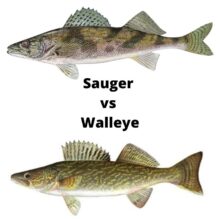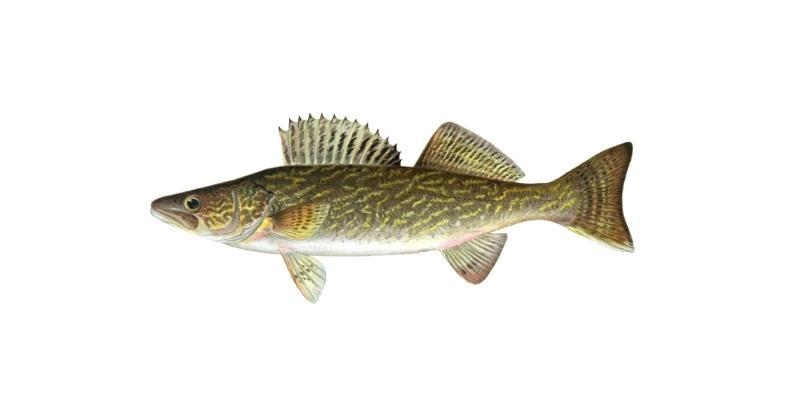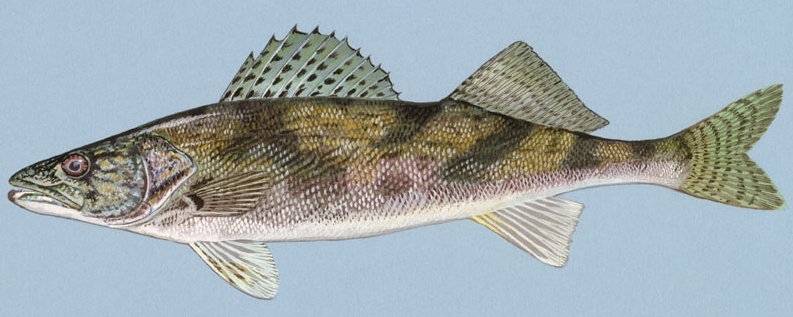This article may contain affiliate links. If you make a purchase after clicking on a link we may earn a small commission at no extra cost to you. As an Amazon Associate, I earn from qualifying purchases.
Sauger vs Walleye – What’s the Difference?

Many anglers will often be confused between Sauger vs Walleye given that they do look very similar.
But what exactly is the difference between Sauger and Walleye and how do you tell them apart?
Knowing how to tell them apart is important as different waters will have separate limits for both Walleye and Sauger and you may well end up keeping more of the limit of one of these species by mistake.
Walleye and Sauger are two of the more popular freshwater fish species that are found throughout most of the United States. These two fish have lots of similarities and many anglers have difficulty telling them apart.
We’ve compiled this article to help establish some of the differences between walleye and sauger and detail some of the ways you can tell one from the other.
Some states may have a significantly lower limit for sauger than for walleye.
Both fish are members of the same family of fish referred to as Perch or Percidae.
Main visual differences between Sauger and Walleyes:
- Size – Walleye will generally grow larger than Sauger although this will depend on the particular location.
- Color – Walleye tend to have a more solid golden body color whereas Sauger have darker areas of blotchy skin color.
- Fins – Sauger have black spots on their dorsal fin and walleye have roughly three darkened spines to the rear of the dorsal fin.
- Tail – Walleye have a very distinctive white patch on the lower half of their tail fin.
Sauger vs Walleye
Sauger are generally smaller, have larger dark blotches on their body and spots on all of the spines on their dorsal fin.
At first glance, these two fish might appear to be the same species. Their overall body shape and coloration is very similar, which often leads to even experienced anglers having trouble telling which type of fish they have on the end of their line.
The walleye and sauger are both built with a very similar shape and profile. This is mostly because they are both members of the Percidae family. This fish family also includes other freshwater species like perch, pike, and others.
Also Read: Perch vs Walleye
The walleye and sauger are so similar that there are actually instances in which both of these fish can reproduce a hybrid species that’s known as a “saugeye.” The saugeye are a naturally-occurring hybrid that are found in bodies of water that have healthy, stable populations of both sauger and walleye.
In the following sections, we’ll discuss the sauger and walleye in greater detail, as well as some of the major differences that both species have when compared to one another.
What is a Walleye?
Walleye are one of the more distinct freshwater fish that are found throughout most of the United States and Canada. They are mostly known for having very vibrant, colorful bodies and large eyes. In fact, the walleye draws its name from the fish’s awkward, forward-facing eyes as it seems to have a “wall-eyed” look.

This distinct eye structure helps the walleye to have more adept vision than most other fish species. Walleye use their eyesight to locate prey like perch and bluegill along the shallows of various freshwater lakes and rivers where they live.
Depending on what part of the country you’re in, you might find walleye that have a very dark coloration, or a lighter one that is pale-green or even emerald in color. It is these darker-colored walleye that are most often confused with sauger as their complexions are very similar in many ways.
Walleye are known to be native to the Mississippi River system and areas around the Great Lakes, as well as the Midwest region. In recent decades, they have been introduced to other sections of the country such as the Northwest and even as far south as Texas and as far east as the states along the Atlantic coast.
What is a Sauger?
Sauger are a species of freshwater fish that are incredibly similar to walleye in many ways. However, they are two distinct species and they each have specific characteristics and habits that set them apart from one another. Sauger are not as widespread as walleye, but you can be certain that where you find these fish, you will almost always find walleye in the same waters.

These fish have a virtually identical body shape and profile when compared to the walleye, but there are some distinct differences that can be noted which you can use to tell them apart from one another.
Sauger typically live in bodies of water that have a flowing current instead of large lake and reservoirs where the water lacks a current.
While it is true that sauger prefer to live most of their lives in rivers and large streams, they often migrate and might find themselves in lakes that have a current flowing through them, or a river feeding into the reservoir.
These fish are extremely strong swimmers and anglers often note that a small sauger will fight and pull on their line as hard as a sizable largemouth bass or other similar species.
Since sauger are at home in fast-moving rivers, they are proficient swimmers. This is mostly the reason why they are so powerful and capable of putting up a significant fight against an anglers’ rod and reel.
They are found in river systems that stretch from Montana and Wyoming eastward to New York and parts of Canada. Non-native populations of sauger can be found in various river systems and large reservoirs throughout the southeast all the way out to Colorado and even Idaho.
Size Differences
Walleye are known to be capable of growing much larger than sauger. They are both predatory fish that will devour almost any type of freshwater bait fish and small creatures that they can catch in the bodies of water where they live.
If you catch a fish that resembles a sauger, but is well outside of the normal size range, you can usually be certain that it’s a walleye.
The average walleye tends to grow to about 22 inches in length and typically weighs up to about one pound. Walleye, like sauger, are made with a very slender body that’s torpedo-shaped and allows them to swim with great acceleration and speed. In the right conditions and with an ideal diet, walleye are known to grow to immense sizes compared to the sauger.
Warm-weather climates tend to be more favorable for walleye to grow to their full potential and reach trophy sizes. The current world record walleye is listed as a 25-pound behemoth that also measured 41 inches in length. This fish was caught in 1960 in Old Hickory Reservoir, which is just east of Nashville.
The size limits of the sauger is vastly different from walleye as these fish never reach the massive size that walleye are capable of growing to. Sauger tend to grow to be around 12 to 14 inches when they reach full maturity—even in the best conditions. A trophy-sized sauger is typically considered one that exceeds 15 inches.
Sauger are not as large as walleye, but that doesn’t mean that these fish are necessarily small when compared to other freshwater fish that are in the same family. In the best conditions and environment, sauger usually reach a weight of about 12 ounces. Any sauger over one pound is usually considered to be a trophy-sized fish.
The world record sauger is listed as an 8-pound 12-ounce monster that was caught by an ice fishing angler in 2013 in North Dakota. These fish are known to be extremely feisty and a sauger that tips the scales at more than 2 or 3 pounds will certainly put any anglers’ drag to the test.
Differences Between Walleye and Sauger
There are a few distinct ways you can tell these two species apart. By learning these traits and characteristics, you will be well-equipped to distinguish which type of fish you have caught.
Tail
The walleye’s tail is known to be colored in a similar manner compared to the sauger, but there’s one specific difference. The tail of a walleye will have less vibrant color towards the end of the tail. The very tip of the tail around the edges might often have very little color at all, making it appear transparent.
The tail of a sauger, however, is uniform throughout and has color from one end to the other. The sauger’s tail is also a bit smaller than a walleye of the same size, but this is usually something you wouldn’t notice unless you had two specimens of the same size side-by-side.
Dorsal Fin
The walleye’s dorsal fin is another point of identification that you can use to quickly determine what type of fish you’ve caught.
Walleye have a dorsal fin that usually features a dark, black-colored splotch near the back end of the dorsal fin, as well as toward the top of the fin. The dorsal fin does not have the same transparent appearance that the walleye’s tail should have.
A sauger’s dorsal fin is slightly different in that it has a greenish color that will be speckled with green or brown spots. There will be no black splotches on the dorsal fin of a sauger as you will always find in that of the walleye.
Body Color
A walleye’s body color might be somewhat similar to that of a sauger, but there is often one very notable difference. The body of a sauger will usually have dark black-colored splotches across its body. These splotches might often appear to look like stripes or even similar to a camo-pattern in some cases.
Cheeks
Another way you can quickly identify the fish you’ve caught if you’re not quite sure if it’s a walleye or a sauger is the cheeks. The cheeks, or sides of the head, of the sauger will have a rough feel that should be easily noticeable while the cheeks of a walleye are very smooth and won’t feel rough.
Conclusion
Using these differences and identification points, you should now have a solid understanding of both walleye and sauger, as well as enough information to identify the two. Both species are a lot of fun to catch and they also offer a very sweet, flaky meat that is one of the more desirable when compared to other freshwater fish species.
What is a Saugeye ?
A Saugeye is a hybrid between a Walleye and a Sauger which gains some attributes from both of it’s parents.
They get the same skin tone on their body complete with dark blotches from the Sauger and the same lower white streak on the lower half of their tail fin.
The name Saugeye is often confused with Sauger and it’s an easy mistake to make.
Cross breeding is quite rare and most anglers will rarely if not ever hook a Saugeye.
